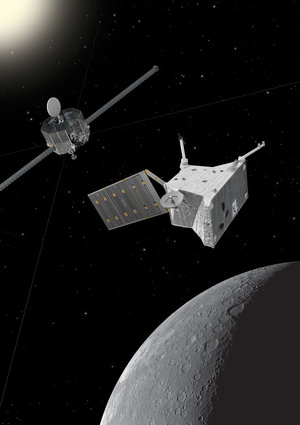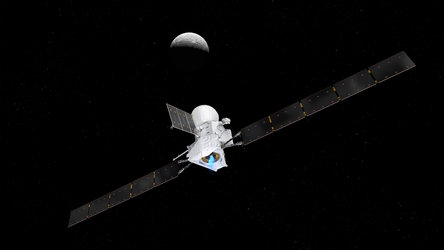Meet Mercury
Among the four inner Solar System planets, Mercury is the smallest and very dense, its vast iron core dominating its internal structure.
As the closest planet to the Sun it experiences extreme temperature variations at its surface, from about +430ºC, down to –180ºC. It has permanently shadowed regions at its poles that never see sunlight and thus enables ice to exist on its floor. Mercury’s ancient, cratered surface shows signs of past volcanic and tectonic activity, and is heavily weathered by the harsh space environment.
Facts about planet Mercury

Diameter: 4879 km (0.38 Earths, or 1.40 Moons)
Surface area: 74.8 million square km (0.147 Earths)
Gravity: 3.7 m/s2 (38% of Earth’s gravity)
Mass: 3.3 × 1023 kg (0.055 Earths)
Density: 5430 kg/m3 (Earth: 5515 kg/m3)
Distance from Sun: 46 001 200 – 69 816 900 km (Earth: 149 597 900 km)
Solar irradiance: 6272 – 14 448 W/m² (Earth: 1366 W/m²)
Day: 58 Earth days to turn once on its axis (Mercury rotation period); 176 days for the Sun to return to the same spot in the sky, as seen from a fixed point on the surface (Mercury solar day)
Year: 88 Earth days to orbit the Sun (Mercury orbital period)
Obliquity to orbit (axial tilt): 0.01° (i.e. the equator of Mercury nearly coincides with the orbital plane of the planet)
Surface temperature: –180ºC (night) to 450ºC (day)
Atmosphere: Very thin (<10–14 bar), including oxygen (42%), sodium (29%), hydrogen (22%), helium (6%) and trace gases
Moons: None
All in a spin
A year on Mercury – one orbit around the Sun – takes just 88 Earth days. On the other hand, the planet takes a whopping 58 Earth days to complete one spin on its own axis. In other words, this unique planet spins three times about its own axis for every two orbits around the Sun. Seen from the surface of Mercury, it takes almost half an Earth year (176 days) for the Sun to return to the same spot in the sky.
Seasons on Mercury are also different to those on Earth. Earth-like seasons are dictated by the planet's axial tilt with respect to the plane it orbits in around the Sun. But Mercury's axis has the smallest tilt of any in the Solar System at just 0.01 degrees, so these kinds of seasons don't exist.
Instead, Mercury has so-called 'thermal seasons', dictated by the distance of the planet from the Sun. This is because of all the planets in the Solar System, Mercury's orbit is the least circular: at its furthest point from the Sun it is 1.5 times further away than when it is at its nearest. Mercury gets hotter when it's closer to the Sun, and colder when it is further away.
In the polar regions the Sun never rises above some crater bottoms, meaning they are in permanent darkness.
At the other end of the scale there are two regions on Mercury’s equator, 180 degrees apart, which always have the Sun directly overhead when the planet is closest to the Sun. If you would stand at either of these points, the Sun would appear to be almost stationary overhead for two to three weeks. This is because the planet orbits around the Sun just as fast as it orbits around its own axis for that period.
At certain points on Mercury’s surface an observer would be able to see the Sun rise about halfway, then set slightly, and then rise again before setting again, all in one Mercury day.








